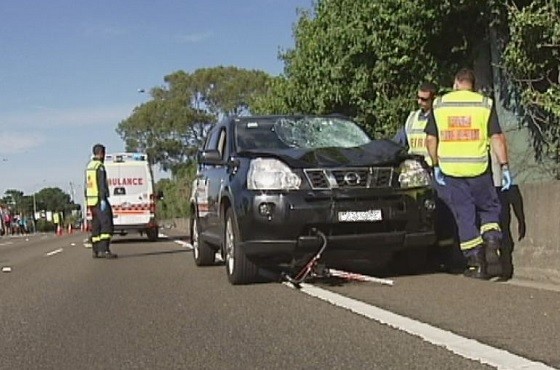
The Australian ran a surprisingly sympathetic feature article by journalist Greg Bearup, Are cyclists fair game in Australia?, in its Weekend Magazine earlier this month.
It’s long (4,100 words) but well worth the effort. In the course of covering a lot of ground Mr Bearup highlights an important issue.
He cites research showing the consequences for a cyclist of a crash are often dire, with 16% of those involved in one requiring a hospital stay longer than a week.
And yet, he says,
The consequences for drivers who kill and maim (cyclists) are often no worse than a minor traffic violation. Sean Sampson, from the cycling safety advocacy group the Amy Gillett Foundation, tells me he doesn’t know of a single incident in Australia where a motorist has been jailed, or received a significant fine, for killing or injuring a cyclist where the motorist was at fault – not one.
To my mind, this quote draws attention to the “bingle mentality” of the policy-makers who build and manage urban roads. Streets are deliberately designed and regulated to tolerate the sort of minor collisions between motorised vehicles that often result in the need for expensive panel beating but don’t usually result in serious injuries or death.
Most times damage is covered by insurance and no one’s seriously hurt; so whichever driver is at fault is issued with the same penalty they’d cop if they were nabbed for breaking the road rules.
That might be a reasonable approach when motorists collide with each other on a suburban street; they’re each protected by a panoply of safety devices like progressively deforming metal bodies, pre-tensioned seat belts, and multiple head, shoulder and knee air bags.
But what’s a mere bingle between cars can be life threatening or maiming for a cyclist who’s involved in a collision with a vehicle.
There’s a huge asymmetry here. For all practical purposes, cyclists do no harm to the occupants of a vehicle in the event of a crash. And of course riders have very few ways to reduce the risk of serious injury or death to themselves.
This imbalance in vulnerability also applies to pedestrians. While there’s still a lot of room for improvement, we figured out long ago that pedestrians need to be separated from road traffic and provided with their own right of way i.e. footpath.
And where pedestrians and road traffic inevitably conflict, pedestrians should have priority e.g. crossings. When I got my driver’s licence back in the day, I was taught that motorists are obliged to give way to pedestrians irrespective of how they behave.
If we want cycling to be safe, we need a similar way of thinking. Policy-makers need to recognise that the “bingle mentality” is no longer a reasonable way to manage use of roads. If drivers were at the same elevated risk of death or serious injury in a crash as cyclists are there’d be no question of the need for drastic action.
Part of the solution must be to increase by an order of magnitude the level of expenditure on segregated bicycle infrastructure. Realistically though, that’s only going to be part of the answer; cyclists will need to share most of the road network with motorists for many years to come.
An equally pressing need is therefore to elevate the status of cyclists on existing roads vis-a-vis motorists. That can be achieved by improving the design of roads and regulating the behaviour of drivers in ways that recognise – and privilege – the vastly greater vulnerability of cyclists.
As I’ve noted before, there are plenty of practical options e.g. Green Street networks, 30 kph speed limits, traffic management infrastructure, public education, enhanced legal status for cyclists.
The “bingle mentality” simply isn’t acceptable any more for roads used by vulnerable travellers such as cyclists and pedestrians.








Crikey is committed to hosting lively discussions. Help us keep the conversation useful, interesting and welcoming. We aim to publish comments quickly in the interest of promoting robust conversation, but we’re a small team and we deploy filters to protect against legal risk. Occasionally your comment may be held up while we review, but we’re working as fast as we can to keep the conversation rolling.
The Crikey comment section is members-only content. Please subscribe to leave a comment.
The Crikey comment section is members-only content. Please login to leave a comment.